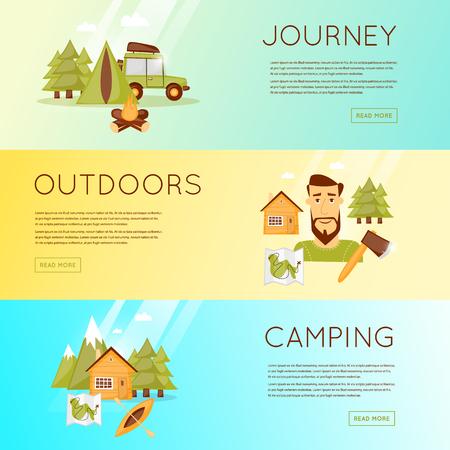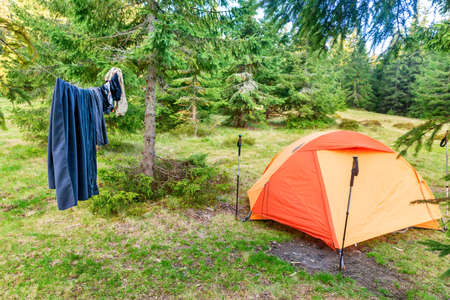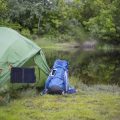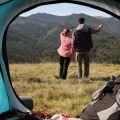1. Shelter and Sleeping Essentials
When youre heading out for your first camping trip, having the right shelter and sleeping gear can make all the difference between a restful night and a restless one. Whether youre camping in warm summer weather or chilly fall evenings, choosing equipment suited for the conditions is key.
Tents: Your Home Away from Home
A reliable tent is essential. Look for one thats easy to set up, durable, and appropriate for the number of people sharing it. For beginners, a 3-season tent is a solid choice since it can handle most weather types except extreme cold or heavy snow.
| Type of Tent | Best For | Key Features |
|---|---|---|
| 2-Person Dome Tent | Couples or solo campers with extra space | Lightweight, easy setup, good ventilation |
| 4-Person Cabin Tent | Small families or groups | Roomy interior, taller height, storage pockets |
| Instant Tent | First-timers looking for convenience | Pops up quickly, minimal setup required |
Sleeping Bags: Stay Warm and Cozy
Your sleeping bag should match the climate youll be camping in. Most bags are rated by temperature, so choose one based on the lowest nighttime temps you expect. Mummy-style bags are great for colder conditions, while rectangular bags offer more room to move around.
Sleeping Bag Temperature Ratings:
| Temperature Rating (°F) | Ideal Use |
|---|---|
| +30°F and above | Summer camping and mild nights |
| +15°F to +30°F | Spring/fall camping with cooler temps |
| 0°F to +15°F | Cold weather or high-altitude trips |
Sleeping Pads: Comfort and Insulation Matter
A sleeping pad adds cushioning and insulation from the cold ground. There are three main types: foam pads, self-inflating pads, and air pads. For beginners, a self-inflating pad offers a nice balance of comfort and ease of use.
| Type of Pad | Pros | Cons |
|---|---|---|
| Foam Pad | Lightweight, budget-friendly, durable | Bulky, less comfortable |
| Self-Inflating Pad | Cushioned support, easy to use | Slightly heavier than foam pads |
| Air Pad | Compact when packed, adjustable firmness | Can puncture, needs inflation effort |
Selecting the right combination of tent, sleeping bag, and sleeping pad will help you sleep soundly under the stars — whether youre at a well-equipped campground or deep in the wilderness. As you gain experience, you’ll learn what works best for your comfort level and camping style.
2. Camp Kitchen Basics
Cooking in the great outdoors can be one of the best parts of camping, especially when youre well-prepared. For first-time campers, having the right kitchen gear makes it easier to enjoy tasty meals and stress-free food prep at your campsite. Heres what you’ll need to get started.
Essential Cooking Gear
Whether youre planning simple hot dogs or gourmet campfire chili, these items are key:
| Item | Purpose |
|---|---|
| Portable Stove | For cooking meals when a campfire isnt practical or allowed |
| Fuel Canisters | Powers your portable stove; make sure its compatible with your stove model |
| Cookware Set (pots, pans) | Durable and compact options designed for outdoor use |
| Cooking Utensils | Spatula, tongs, stirring spoon—lightweight and heat-resistant tools work best |
| Lighter or Waterproof Matches | To start your stove or campfire quickly and safely |
Food Storage and Prep Tools
A good setup helps keep your food fresh and safe from wildlife.
| Item | Purpose |
|---|---|
| Cooler with Ice Packs | Keeps perishables cold; choose a size based on how long youll be camping |
| Cutting Board and Knife | Makes prepping ingredients easier and safer |
| Reusable Food Containers or Zip Bags | Store leftovers or pre-chopped ingredients efficiently |
| Biodegradable Soap and Sponge | Cleans dishes while being eco-friendly to the environment |
Pro Tips for Camp Cooking
- Prep meals at home: Chop veggies, marinate meats, and portion out ingredients before heading to camp.
- Avoid glass containers: They’re heavy and can break easily. Go for lightweight plastic or metal alternatives.
- Bearing-proof your food: Store food in sealed containers and keep it in your vehicle or bear-safe box if available.
- Bring extras: Pack extra utensils, fuel, and napkins—you’ll thank yourself later!
The right camp kitchen setup helps you cook delicious meals with less hassle. As a first-time camper, starting with these basics will set you up for success around the fire—or stove.

3. Clothing and Personal Gear
When youre heading out on your first camping trip, choosing the right clothing and personal gear can make or break your experience. Weather in the great outdoors can be unpredictable, so it’s important to pack smart based on the season and location of your campsite. Whether youre hiking through mountain trails or relaxing by a lakeside campground, comfort and protection should be top priorities.
Layering Is Key
Instead of packing bulky items, think in layers. This helps you stay warm when its cold and cool when it’s hot. A simple layering system includes:
| Layer | Purpose | Recommended Materials |
|---|---|---|
| Base Layer | Wicks moisture away from skin | Polyester, Merino wool |
| Mid Layer | Provides insulation | Fleece, down, synthetic fill |
| Outer Layer | Protects against wind and rain | Waterproof jacket, shell with hood |
Footwear Matters More Than You Think
Your shoes will do a lot of work during your camping adventure. Invest in a good pair of hiking boots or trail shoes that offer support and traction. Make sure to break them in before your trip to avoid blisters. Don’t forget extra pairs of moisture-wicking socks—they’ll keep your feet dry and comfortable.
Rain Gear: Better Safe Than Soaked
No one likes being caught in the rain unprepared. A lightweight, packable rain jacket and rain pants can save the day. Even if the forecast looks clear, weather can change fast—especially in mountainous regions.
Other Essentials for Your Comfort and Hygiene
- Hat & Gloves: Even summer nights can get chilly.
- Sunscreen & Lip Balm: Protect against sunburn at high altitudes or open spaces.
- Insect Repellent: Especially important near lakes or wooded areas.
- Personal Toiletries: Toothbrush, biodegradable soap, hand sanitizer, and quick-dry towel.
- First Aid Kit: Always have basic supplies like band-aids, antiseptic wipes, and pain relievers.
Packing Tip:
Use zip-top bags or packing cubes to organize your gear by category—this makes it easy to find what you need without unpacking everything.
Remember:
The key is to pack light but smart. Choose versatile items that can handle changing conditions without taking up too much space in your backpack or duffel bag.
4. Lighting and Power Solutions
When the sun goes down, having the right lighting and power gear can make or break your camping experience. Whether youre navigating the trail back to your tent or setting up your campsite after dark, good lighting is key for safety and convenience. Heres what you need to stay well-lit and powered up during your outdoor adventure.
Essential Lighting Tools
There are a few must-have items when it comes to lighting up your campsite. Each has its own purpose, so its smart to bring more than one type:
| Item | Best For | Why You Need It |
|---|---|---|
| Headlamp | Hands-free tasks like cooking or walking at night | Lightweight and directs light wherever you look |
| Lantern | Campsite setup, inside tents, group activities | Provides 360-degree illumination for larger areas |
| Flashlight | Spot lighting and emergencies | A strong beam for focused visibility |
Don’t Forget Extra Power
Your lights are only as good as their power source. Make sure to pack extra batteries for all your devices. If youre using rechargeable headlamps or lanterns, bring a reliable power bank to keep everything charged—especially on multi-day trips.
Recommended Power Essentials:
- Extra Batteries: Always bring spares that match your devices requirements (AA, AAA, etc.).
- Portable Power Bank: Useful for recharging phones, cameras, and rechargeable lights.
- Solar Charger (optional): A great eco-friendly option if youll be off-grid for several days.
Pro Tip:
Aim for LED lighting tools—they last longer and use less power. Also, consider red-light modes on headlamps for preserving night vision around the campfire.
5. Navigation and Safety Gear
When youre out in the wild for the first time, getting lost or dealing with unexpected situations can quickly turn an adventure into a stressful experience. That’s why having the right navigation and safety gear is absolutely essential for first-time campers. These tools not only help you find your way but also keep you safe in case of emergencies.
Stay on Track
Even if you’re camping at a well-known site, trails can be confusing, especially after dark or in bad weather. Always carry:
- Map and Compass: Old-school but reliable, especially when GPS fails due to no signal.
- GPS Device: Handy for tracking your location and navigating unfamiliar terrain.
Be Prepared for Emergencies
Accidents happen—even on short trips. It’s smart to pack items that can help in unexpected situations:
- First-Aid Kit: Include bandages, antiseptics, tweezers, pain relievers, and any personal medications.
- Multi-Tool: A compact tool that includes a knife, scissors, screwdriver, and more can be a lifesaver.
- Emergency Whistle: A simple way to signal for help if needed.
- Portable Power Bank: Keeps your phone or GPS charged in case of emergency.
- Personal Locator Beacon (PLB) or Satellite Messenger: Useful in remote areas without cell service; these devices can alert rescuers to your location.
Quick Safety Gear Checklist
| Item | Why You Need It |
|---|---|
| Map & Compass | No batteries needed; always reliable |
| GPS Device | Easily track your location and route |
| First-Aid Kit | Treat injuries quickly and prevent infection |
| Multi-Tool | Versatile tool for repairs or emergencies |
| Emergency Whistle | Loud sound carries far for help signals |
| Portable Power Bank | Keeps electronics powered up |
| SOS Device (PLB/Satellite Messenger) | Sends emergency alerts when off-grid |
Packing smart navigation and safety tools gives you peace of mind so you can focus on enjoying nature. Whether you’re hiking deep into the woods or setting up camp near your car, being prepared is key to a great outdoor experience.


